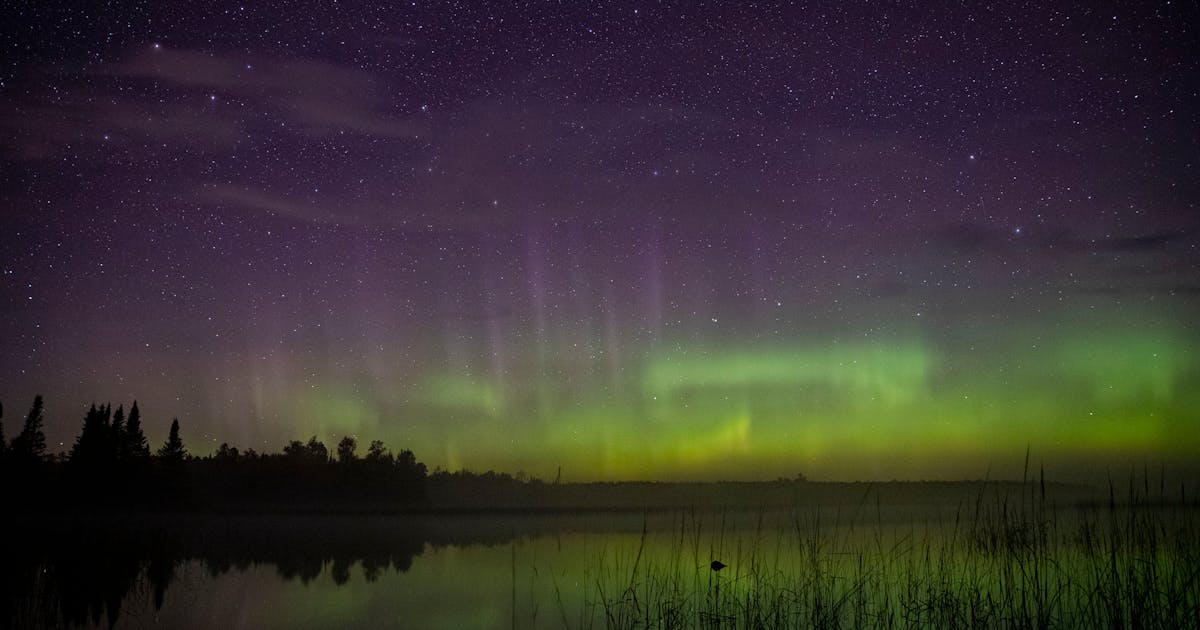OPINION EXCHANGE | Climate change and the dog-poop principle
Climate change and the dog-poop principle Star Tribune


Opinion: The Importance of the Sustainable Development Goals (SDGs)

Opinion editor’s note: Star Tribune Opinion publishes a mix of national and local commentaries online and in print each day. To contribute, click here.
The Beauty of the Northern Lights and the Threat to Our Environment
I picked my way in darkness to the shore of Secret Lake — to wait and watch, for hours if necessary. A space weather forecast indicated a northern lights display was likely and I’d missed some spectacular shows the past few years due to clouds or travel. If the sky remained clear I’d be under it, bundled up and settled on a bench.
To my initial delight, a soft auroral glow suffused the northern horizon, a belt 15 to 20 degrees wide. The bright star Capella had just risen, twinkling through the mist of light and the sweeping limbs of spruce and tamarack. But to the west a dark vanguard of cloud seemed poised to advance.
I’ve observed and recorded 1,083 auroras since the mid-1960s and have contributed detailed observational data to researchers, so I knew this glow might be precursor to a celestial storm or just as likely fizzle, or be obscured by the overcast that I could now see was slowly approaching.
- Ten minutes passed and the glow remained static.
- Twenty minutes and no change, except the western clouds were closer, about to engulf the prominent star Arcturus.
- Thirty minutes and the glow had stretched a little higher, but was still formless and no brighter. Arcturus had disappeared, as well as the northwestern end of the glowing belt. I braced for disappointment.
At around forty minutes I noticed a brightening spot in the handle of the Big Dipper, and the entire glow seemed “denser.” I thought, “Here it comes — maybe.” I inwardly winced when the bright spot faded, but four such spots abruptly appeared along the horizon and rapidly elongated into shimmering white “rays” fringed with pale green. All the light intensified. Then, igniting in the northwest, the sky erupted. From behind the clouds auroral “flames” surged for the zenith and in seconds spread across the entire sky. I laughed and thrust my arms skyward — an ecstatic fan — then hustled back up to the cabin to alert Pam.
We deployed lawn chairs and marveled as the sky pulsated in swells of feathery light, a pageant of the northern world. I’ve never tired of the show, and along with old white pines, icy rivers flush with snowmelt, dazzling fall leaves, loon yodels and other icons of the boreal forest, the aurora evokes a spirited sense of place. Which is odd in a way since the northern lights are not part of the biosphere. Unlike the influence we exert on many constituents of the Earth’s life zone, humans lack the capacity to fold, bend, spindle or mutilate the aurora — the rays and flames will sprightly cavort undiminished above the lichened ruins and scattered bones of our civilization.
The Threat to Our Environment and the Need for Action
That bleak image sprang to mind, I think, because our sense of place and our devotion to that locale is under threat by ecological compromises and the blitzkrieg of climate disruption. I’m watching the boreal forest change at a startling rate, and being a compulsive record-keeper have nearly five decades of documentation to prove it — high/low temperatures, phenology, seasonal shifts in patterns of precipitation and warmth, the numbers and behavior of animals — most particularly that of insects and birds.
I contribute regular checklists to eBird, a worldwide database for birders and ornithologists. A few years ago in early spring I spotted a Connecticut warbler in the bog surrounding Secret Lake, and logged it in. Next day I received an email from a skeptical regional overseer of the eBird site, requesting details of the observation. I responded, and was informed that if correct (I had no doubt), it was the earliest recorded appearance of a Connecticut warbler in northeastern Minnesota by about two weeks. Cool, but also distressing — possibly speaking to the warming of the North, which if it continues apace could transform these woods into sunbaked prairie and bare ledgerock.
Everything changes, of course, and 12,000 years ago our homesite was under a mile or so of glacial ice. But we humans had nothing to do with that. We have much to do with a Connecticut warbler showing up too early and perhaps struggling to find food. Any alert observer can witness such shifts. For example, it’s obvious that fireflies are vanishing. Where we routinely saw hundreds of blinking bugs — like star clusters amid the trees — there are now just two or three or none. How is it possible we’re decimating insect populations? We are badass — wizards of toxicity.
Still, a few weeks ago I found some slightly perverse encouragement.
I walk our dog along a beach at a nearby state park where she seems to relish the sand. I keep a stash of poop bags in my pockets and dutifully pick up and pack out her fecal deposits. Not everyone does, but what confounds me are those people who trouble to pick up a turd, tie off the bag, then just leave it behind. I find that more irritating than the owners who do nothing. Perhaps that’s because I’ll pick up those abandoned bags and carry them out, and that’s what the “leavers” hope — or even expect — others to do. Whether it’s litter or global warming, someone else will take care of it.
A few weeks ago we came across a bulging poop bag left in the sand about five feet from the water’s edge. My hackles rose and when I bent over to snag it, I saw a neatly folded dollar bill had been tucked beside the bag. Here, apparently, was a person able to do their duty only halfway, but was willing to pay someone else to go the full monte. To assuage guilt? Maybe, but a five-dollar bill would’ve supplied more convincing atonement.
Still, lame as it was, the one-dollar “tip” did
SDGs, Targets, and Indicators Analysis
1. Which SDGs are addressed or connected to the issues highlighted in the article?
- SDG 13: Climate Action
- SDG 15: Life on Land
The article discusses the issues of climate disruption, ecological compromises, and the impact on the boreal forest and wildlife. These issues are directly connected to SDG 13, which focuses on taking urgent action to combat climate change and its impacts. Additionally, the article mentions the changes in the boreal forest and the behavior of insects and birds, highlighting the importance of preserving life on land, which is addressed in SDG 15.
2. What specific targets under those SDGs can be identified based on the article’s content?
- SDG 13.1: Strengthen resilience and adaptive capacity to climate-related hazards and natural disasters
- SDG 13.2: Integrate climate change measures into national policies, strategies, and planning
- SDG 15.1: Ensure conservation, restoration, and sustainable use of terrestrial and inland freshwater ecosystems
- SDG 15.5: Take urgent and significant action to reduce degradation of natural habitats
Based on the article’s content, the targets mentioned above are relevant. Strengthening resilience to climate-related hazards and integrating climate change measures into policies and planning are crucial for addressing climate disruption (SDG 13). Ensuring the conservation and sustainable use of terrestrial ecosystems, as well as reducing degradation of natural habitats, are important for preserving life on land (SDG 15).
3. Are there any indicators mentioned or implied in the article that can be used to measure progress towards the identified targets?
- Number of observed and recorded auroras (indicator for SDG 13.1)
- Documentation of high/low temperatures, phenology, and shifts in patterns of precipitation and warmth (indicators for SDG 13.2)
- Checklists of bird species and their behavior (indicator for SDG 15.1)
- Observation of changes in insect populations, such as fireflies (indicator for SDG 15.5)
The article mentions the author’s extensive observation and recording of auroras, which can serve as an indicator for measuring progress towards strengthening resilience to climate-related hazards (SDG 13.1). The author also mentions their documentation of temperature, phenology, and precipitation patterns, which can be used as indicators for integrating climate change measures into policies and planning (SDG 13.2). Additionally, the author’s contribution of bird checklists and observation of changes in insect populations can be indicators for the conservation and sustainable use of terrestrial ecosystems and the reduction of habitat degradation (SDG 15.1 and SDG 15.5).
4. Table: SDGs, Targets, and Indicators
| SDGs | Targets | Indicators |
|---|---|---|
| SDG 13: Climate Action | 13.1: Strengthen resilience and adaptive capacity to climate-related hazards and natural disasters | Number of observed and recorded auroras |
| SDG 13: Climate Action | 13.2: Integrate climate change measures into national policies, strategies, and planning | Documentation of high/low temperatures, phenology, and shifts in patterns of precipitation and warmth |
| SDG 15: Life on Land | Checklists of bird species and their behavior | |
| SDG 15: Life on Land | 15.5: Take urgent and significant action to reduce degradation of natural habitats | Observation of changes in insect populations, such as fireflies |
Behold! This splendid article springs forth from the wellspring of knowledge, shaped by a wondrous proprietary AI technology that delved into a vast ocean of data, illuminating the path towards the Sustainable Development Goals. Remember that all rights are reserved by SDG Investors LLC, empowering us to champion progress together.
Source: startribune.com

Join us, as fellow seekers of change, on a transformative journey at https://sdgtalks.ai/welcome, where you can become a member and actively contribute to shaping a brighter future.







